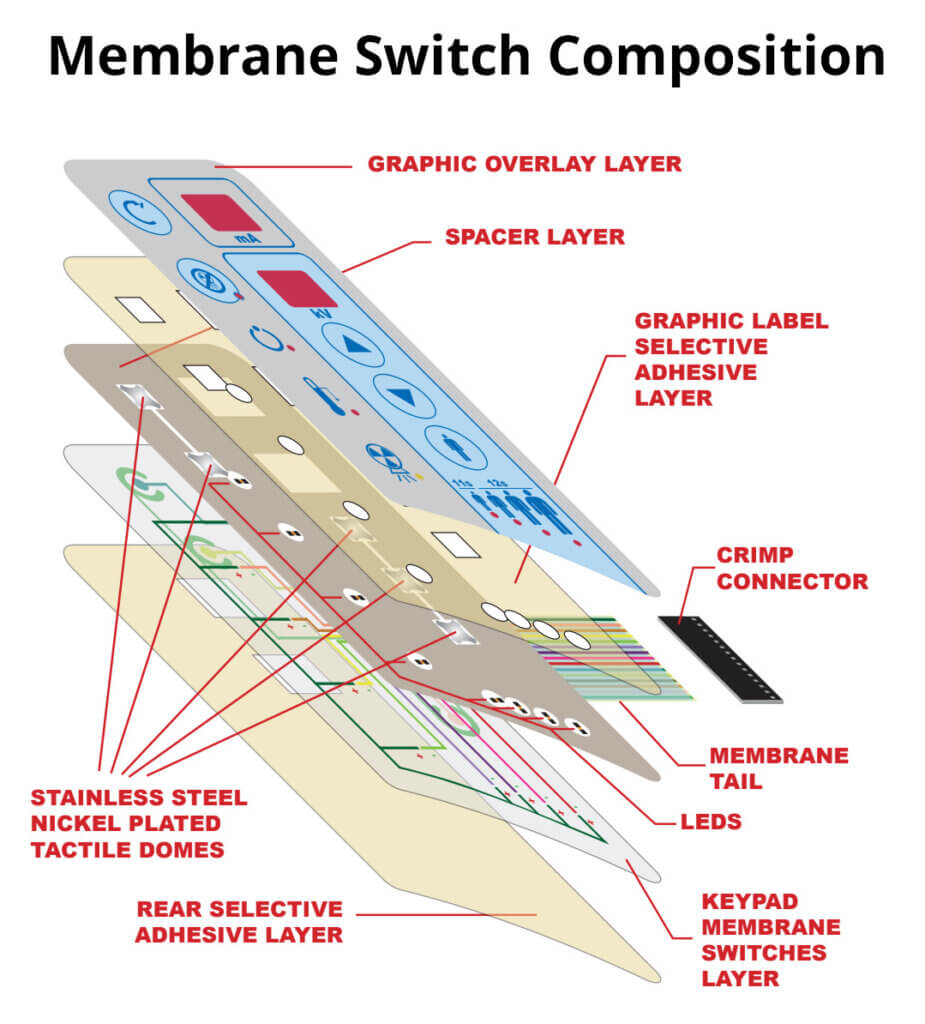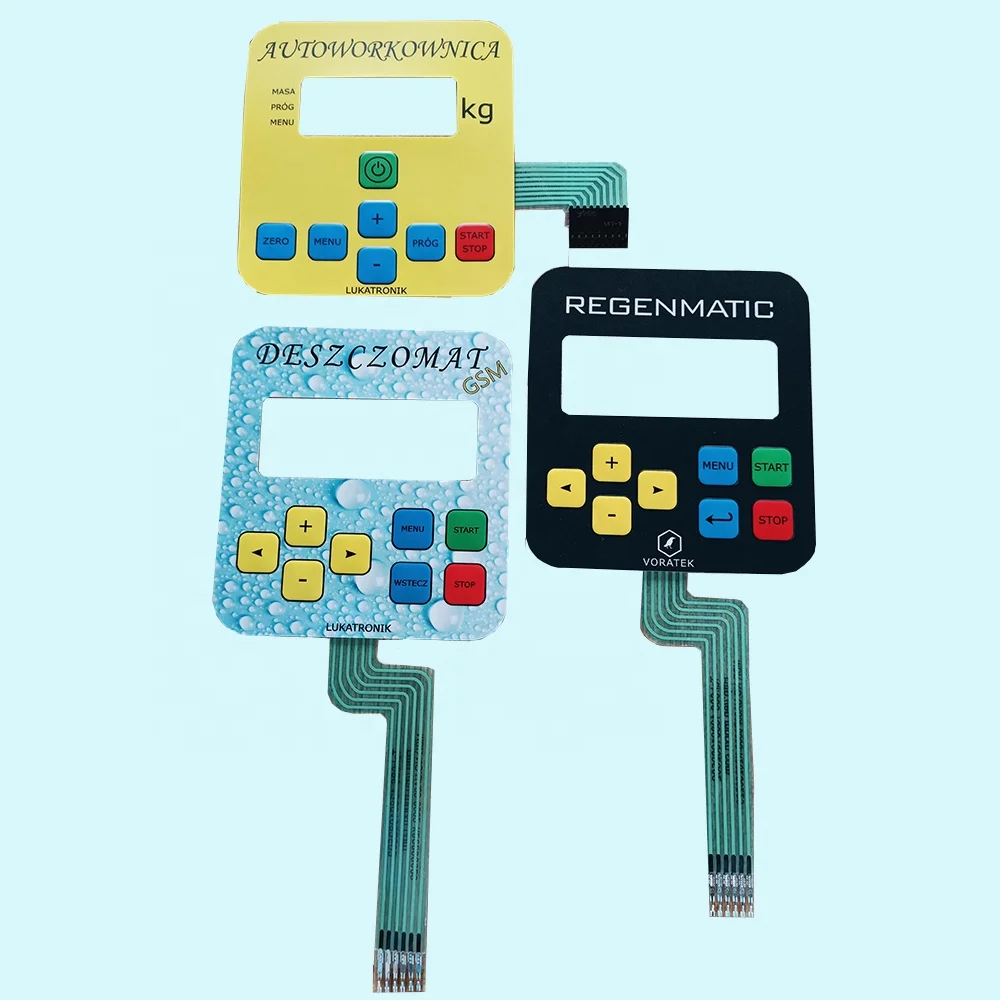Checking Out the Manufacturing Refine of Membrane Switch for Various Industries
The production process of Membrane switches is a complex undertaking that demands accuracy and attention to information. From picking ideal products to executing rigorous quality assurance measures, each action plays an important duty in guaranteeing functionality. Different industries, including automotive and clinical, rely upon these components for their unique applications. Understanding the ins and outs of this procedure discloses substantial understandings into just how these switches are created and their impact across varied markets.
Comprehending Membrane Switches Over: A Summary

Key Products Made Use Of in Membrane Switch Production
In Membrane switch manufacturing, the option of key materials significantly influences functionality and toughness. Conductive materials, adhesives, and finishes play important roles, while substratum option impacts overall efficiency and integrity. Understanding these components is essential for enhancing the layout and production of Membrane buttons.
Conductive Products Overview
Conductive products play a vital duty in the capability of Membrane buttons, making sure dependable electrical links within the gadget. Typically used materials consist of silver, copper, and carbon-based inks, each offering unique benefits. Silver is preferred for its high conductivity and longevity, making it perfect for applications requiring durable efficiency. Copper, while slightly much less conductive than silver, is an affordable alternative often utilized in printed circuits. Carbon-based inks give a functional choice, appropriate for applications where adaptability and reduced prices are prioritized, although they have actually reduced conductivity compared to metal options. The choice of conductive products straight affects the overall dependability, life-span, and efficiency of the Membrane switch, making it an essential consideration in the production process.
Adhesives and Coatings
Layers and adhesives are important components in the production of Membrane buttons, offering important bonding and protective homes. These materials assure that numerous layers of the switch, consisting of visuals overlays and wiring, stick firmly to one an additional, boosting longevity and performance. Commonly used adhesives consist of pressure-sensitive adhesives (PSAs) and epoxy-based formulations, which provide strong attachment and durability. Coatings, such as polyurethane or acrylic, serve to safeguard against environmental aspects, consisting of wetness, abrasion, and chemicals. In addition, finishes can enhance responsive comments and visual charm, contributing to the overall customer experience. The selection of appropriate adhesives and finishes is crucial for maximizing efficiency and long life in varied applications across various industries, making certain that Membrane switches over satisfy particular functional demands.
Substratum Selection Factors
Substrate choice plays an important function in the manufacturing of Membrane buttons, as it significantly influences their overall performance and toughness. Key materials such as polyester, polycarbonate, and versatile printed circuit card (FPCBs) are commonly made use of for their distinct residential or commercial properties. Polyester is favored for its cost-effectiveness and resistance to abrasion, making it suitable for applications with high wear. Polycarbonate offers superior clarity and influence resistance, perfect for environments calling for high exposure. FPCBs provide improved versatility and are commonly utilized in intricate designs. The option of substratum additionally affects factors like thermal security, chemical resistance, and simplicity of printing. Inevitably, choosing the ideal substrate is critical for making sure the functionality and durability of Membrane switches over throughout numerous markets.
The Style Process of Membrane Changes
The design process of Membrane switches is an essential phase that considerably affects the capability and aesthetic appeals of the last product - membrane switch manufacturer. It starts with specifying the particular requirements of the application, including measurements, switch layout, and responsive comments preferences. Developers need to consider individual communication, guaranteeing that the switch is instinctive and accessible.Next, materials are selected based on toughness, versatility, and environmental resistance. The integration of graphics and branding aspects is additionally vital, as it improves visual charm and interaction. Prototyping permits repetitive screening, allowing adjustments based upon user feedback and efficiency evaluations.Additionally, the layout must make up the electric elements, such as connectors and circuits, making sure dependability and ease of use. Ultimately, a successful design integrates functionality, appearances, and user experience, leading the way for effective production and durable performance in various sectors
Printing Techniques for Membrane Changes
The printing techniques utilized in Membrane button production play an essential function in determining the end product's high quality and capability. Screen printing uses benefits such as longevity and vivid shade application, while electronic printing technologies supply flexibility and precision in design. Recognizing these methods can significantly affect the total effectiveness of Membrane buttons in numerous applications.
Display Printing Benefits
Various benefits make screen publishing a recommended strategy for generating Membrane buttons. This technique permits high-quality, thorough layouts and lively shades, which are important for interface applications. Display printing is especially reliable for applying thick ink layers, boosting longevity and responsive comments. Furthermore, my response it provides outstanding attachment to different substrates, making certain long life in requiring environments. The process is cost-efficient for large production runs, as it minimizes configuration time and waste. Moreover, screen printing sustains a large array of inks, including specialty and UV-curable alternatives, allowing versatility in style. Its capability to generate constant results across multiple devices makes it a reliable option for producers going for top quality and effectiveness in Membrane switch manufacturing.
Digital Printing Innovations

Improvements in electronic printing modern technology are transforming the manufacturing of Membrane buttons, offering makers cutting-edge remedies that improve design flexibility and efficiency. Digital printing enables pop over to this web-site for intricate styles and high-resolution graphics, allowing customized branding and performance without the constraints of standard techniques. This technique decreases configuration times and expenses, promoting much shorter manufacturing runs and very little waste, making it ideal for companies with differing demands. In addition, improvements in ink formulas supply much better sturdiness and attachment, making sure durability in different atmospheres. As markets increasingly seek personalized and complex designs, digital printing stands out as a vital technique, establishing a brand-new standard in Membrane button production. The assimilation of these developments settings suppliers to meet developing market needs efficiently.
Assembly and Layering of Membrane Switch Parts
Cautious setting up and layering of Membrane button parts are important to guaranteeing functionality and toughness. This procedure starts with the specific placement of different layers, consisting of the visuals overlay, sticky, circuit layer, and backing material. Each component should be thoroughly positioned to maintain electric stability and interface responsiveness.During setting up, conductive traces are applied to the circuit layer, usually made from materials like polyester or polycarbonate. This layer is vital, as it beams when pressure is used. The glue utilized for bonding these layers is additionally selected for its capability to endure ecological stress and anxieties while preserving a protected bond.Heat and pressure are often used during the assembly process to identify that the layers stick appropriately without compromising the functionality of the switch. Ultimately, interest is offered to the edge securing to secure versus wetness and impurities, securing the long life of the Membrane button in numerous industrial applications.
Top Quality Control Actions in Membrane Switch Manufacturing
Quality assurance procedures play an essential role in making certain the integrity and efficiency of Membrane switches over complying with the assembly and layering of their components. In the manufacturing process, a number of essential assessments are carried out to copyright quality requirements. These consist of visual assessments for flaws in printing and adhesive application, in addition to useful examinations to validate the responsiveness of each switch.Additionally, ecological testing is done to assess the switches' toughness against temperature level variations and moisture exposure. Producers frequently carry out analytical procedure control (copyright) methods to keep track of production consistency, allowing very early discovery of anomalies.Furthermore, traceability systems are established to track elements and products, guaranteeing responsibility and facilitating recalls if needed. Calibration of tools and adherence to industry requirements are likewise crucial to keeping product integrity. Collectively, these quality assurance procedures guard the performance of Membrane changes across various applications, ultimately enhancing customer fulfillment.
Applications of Membrane Switches Across Different Industries
Membrane switches are utilized across a varied selection of sectors, showcasing their convenience and adaptability. In the clinical industry, they click site offer water-proof and reliable interfaces for tools such as analysis tools and infusion pumps, making sure health and convenience of usage. The automobile industry utilizes Membrane switches for dashboard controls, allowing smooth communication in between the vehicle driver and automobile systems.In consumer electronic devices, these switches are found in appliances and portable gadgets, supplying a smooth, modern visual while enhancing capability. Industrial applications likewise take advantage of Membrane changes for equipment control board, where resilience and resistance to harsh problems are essential.Furthermore, the aerospace and protection markets utilize Membrane switches for cabin instrumentation and interaction systems, prioritizing reliability and efficiency under extreme conditions. In general, Membrane buttons play an important duty in improving the user experience and functional performance across various domain names.
Frequently Asked Concerns
How Long Does It Take to Manufacture a Membrane Layer Switch?
The manufacturing time for a membrane layer switch typically ranges from a few days to a number of weeks - membrane switch manufacturer. Factors influencing this duration consist of layout intricacy, product accessibility, and manufacturing volume, all affecting the general timeline considerably
What Is the Normal Life-span of a Membrane Switch?
The typical lifespan of a membrane button typically varies from 1 to 5 million actuations, depending on variables such as material top quality, ecological conditions, and usage frequency, substantially impacting longevity and total efficiency.
Can Membrane Switches Be Custom-made for Specific Applications?
Membrane switches can undoubtedly be personalized for certain applications. Their design versatility enables changes in size, shape, colors, and graphics, ensuring compatibility with special demands throughout different sectors and boosting capability and individual experience.

Are Membrane Switches Environmentally Pleasant?
The ecological effect of Membrane switches over differs. Some products used may not be environmentally friendly, while innovations in manufacturing processes are increasingly concentrating on sustainability, aiming to minimize waste and advertise recyclable elements in their manufacturing.
What Are the Common Failure Settings of Membrane Buttons?
Usual failing settings of Membrane switches consist of delamination, glue failing, deterioration from usage, moisture access, and electrical failings. These problems can significantly influence functionality, performance, and lifespan in different applications throughout different industries. Membrane buttons can be customized to fit details layout needs, such as capability, shape, and size, making them very adaptable.The construction commonly involves multiple layers, including a visuals overlay, sticky, and a circuit layer, which function with each other to produce a smooth individual experience. In Membrane switch manufacturing, the choice of crucial products greatly influences functionality and longevity. The automotive industry employs Membrane buttons for control panel controls, enabling smooth interaction between the driver and vehicle systems.In consumer electronics, these switches are found in appliances and portable gadgets, using a smooth, modern aesthetic while enhancing capability. Industrial applications additionally utilize Membrane switches for machinery control panels, where toughness and resistance to extreme conditions are essential.Furthermore, the aerospace and protection fields use Membrane buttons for cabin instrumentation and communication systems, prioritizing reliability and efficiency under severe conditions. Membrane switches can indeed be personalized for particular applications.
Comments on “Membrane Switch Manufacturer with Quick Prototyping and Lead Time”